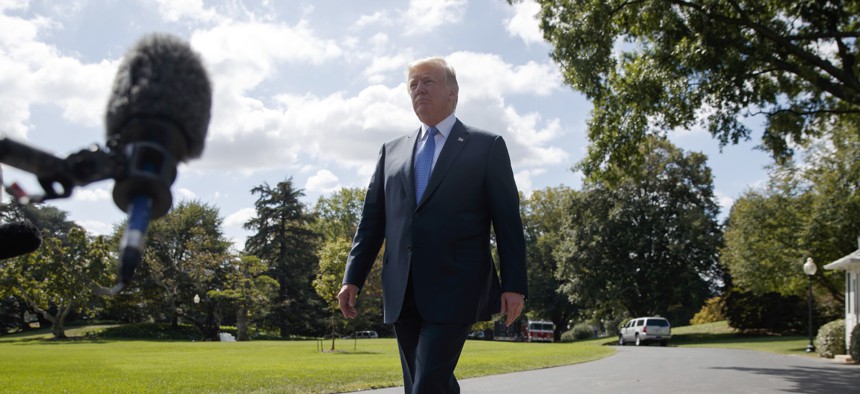
President Donald Trump talks to reporters as he walks to board Marine One on the South Lawn of the White House, Wednesday, Sept. 27, 2017, in Washington. Evan Vucci/AP
Waltzing Toward a Two-Front Global War
The U.S. just might be one step away from a war with North Korea, and two from a fight with Iran.
A few years ago, a Heritage Foundation analysis argued that the sine qua non of a superpower was the ability to fight two major campaigns in different regions of the globe nearly simultaneously. That same report noted that reduced defense investment and a decade of counterinsurgency campaigns had left the U.S. military unprepared to do so.
Nonetheless, the U.S. finds itself one step away from war on the Korean Peninsula and perhaps two from military confrontation with Iran, dancing an uncertain waltz in which a misstep would be catastrophic.
The heated rhetoric between President Trump and North Korea’s Kim Jung-un is unprecedented — certainly from the American side. Each has threatened to destroy the other’s country, and in response, both sides have taken military steps that the other is bound to see as provocative. Last weekend, U.S. bombers conducted a show-of-force mission just east of North Korea, “flying further north of the demilitarized zone…than any other mission this century.” In response, the North Korean foreign minister announced that “we will have every right to make counter measures, including the right to shoot down the United States strategic bombers, even when they are not yet inside [our] airspace.” While some may dismiss these threats as empty gestures, there is a history of North Korean attacks on U.S. military forces in similar circumstances, including seizing the USS Pueblo in 1968 and, the following year, downing an unarmed U.S. naval reconnaissance aircraft in international airspace, killing 31 crew members and trainees on board. According to recently declassified documents, President Nixon at the time was presented with “a wide-range of [military] options including the use of tactical nuclear weapons to a full U.S. military response.” While war was avoided then, there is no such guarantee today if Kim decides to test President Trump in similar fashion.
With regard to Iran, the United States is two steps away from sliding toward conflict. On Oct. 15, President Trump will likely decline to renew his previous certifications of the Iran nuclear deal — formally known as the Joint Comprehensive Plan of Action. A longtime critic of the JCPOA, the president last week called it “an embarrassment to the United States” and said he had already made a decision about recertifying it. If he does not, the second shoe to drop would be a decision by the U.S. Congress to re-impose the nuclear-related sanctions that were suspended under the deal. That would violate the essence of the deal, and Iranian hardliners would push to rapidly reconstitute their nuclear program — a program that once came within weeks of acquiring enough fissile material for a bomb. This would no doubt spur a chorus of calls for strong preventive U.S. military action from lawmakers at home, leaders in Israel, and the Arab Gulf states.
Both of these dangerous scenarios could unfold nearly simultaneously, and not just because tensions are rising at the same time. Either one could ignite the other. Leaders in Pyongyang and Tehran are already convinced that the true goal of U.S. policymakers is regime change. U.S. military strikes against either Korea or Iran will convince other endangered authoritarian regimes that developing nuclear weapons remains their sole effective deterrent.
Even if U.S. policymakers manage to limit military actions to one theater, the launch of yet another major American military commitment will likely embolden bad actors in other regions to press their advantages closer to home. Should the United States become distracted, for instance, Russia might move more aggressively in Eastern Europe or Syria. China could take even more provocative actions in the South China Sea. Non-state actors such as al Qaeda, ISIS, and narco-terrorist groups could seek additional footholds in Africa or Latin America. The table for multiple U.S. military confrontations on a global scale is thus set.
Of course, none of these scenarios is inevitable. But none — alone or in combination — is unimaginable. Avoiding these disastrous outcomes should be the overriding focus of American policymakers. This waltz will require foresighted thinking, as well as skillful and nuanced action on the part of the Trump administration in full coordination with American partners and allies.
In particular, President Trump needs to be more careful with his rhetoric. Every public reiteration of America’s ability to reduce a country to rubble in the absence of visible U.S. decisive action degrades the credibility of that threat, and its effectiveness as a deterrent. Second, national security officials must privately develop and then publicly articulate a clear set of redlines that if violated by leaders in Pyongyang or Tehran will prompt U.S. military action. Third, the administration must invest much more heavily in public and private diplomacy with allies and foes alike. This is an especially difficult task with North Korea and Iran, given the absence of formal diplomatic relations. The U.S. relies on third-party channels such as the Swiss Embassy in Tehran and the Swedish Embassy in Pyongyang. These intermediary agents are simply incapable of reliably communicating sensitive exchanges from top U.S. administration officials at times of crisis. These channels should be supplemented by official talks when appropriate (U.S. Secretary of State Tillerson’s single meeting with Iranian Foreign Minister Zarif is insufficient) and trusted private envoys in cases when it is not. These actions alone won’t guarantee success, but they would go a long way to avoiding a catastrophic miscalculation or misunderstanding that leads to unnecessary conflict.




